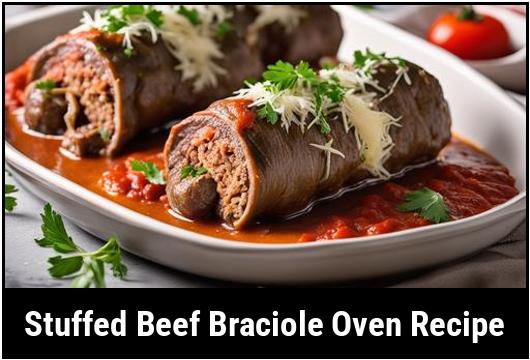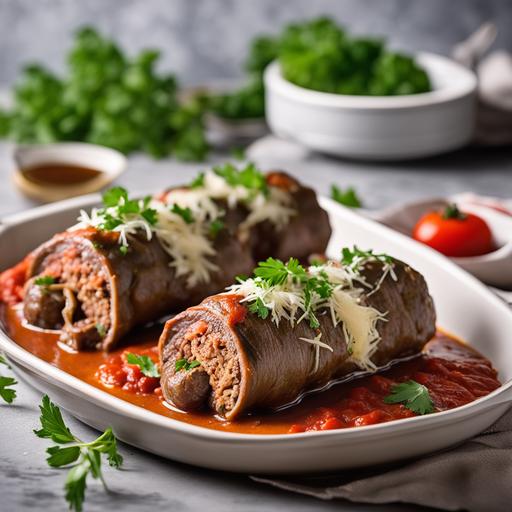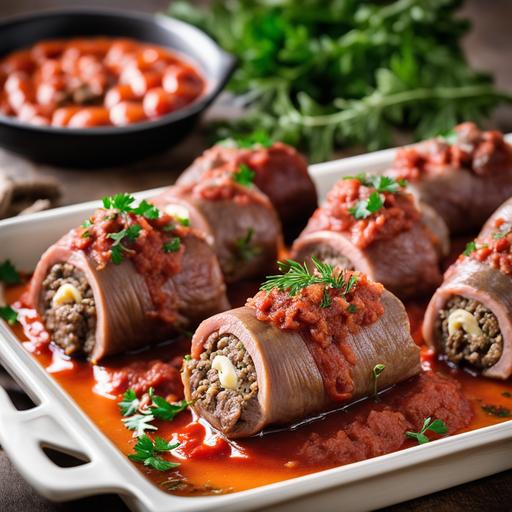
Stuffed Beef Braciole Oven Recipe: A Delicious And Comforting Italian Dish
Nothing says comfort quite like an Italian dish simmering on the stove. And one dish that never fails to impress is the stuffed beef braciole. The combination of tender beef, flavorful fillings, and rich sauce all come together in a symphony of flavors. In this comprehensive article, we will delve into the world of stuffed beef braciole, exploring its culinary origins, food science behind its preparation, essential culinary details, selection, cleaning, preparation techniques, tips, variations, doneness checks, and, of course, a delectable recipe. So, let’s begin our culinary journey!
Understanding the Food Science behind Stuffed Beef Braciole
To truly appreciate the art of making stuffed beef braciole, it’s helpful to understand the food science behind it. The dish consists of thinly pounded beef, filled with a savory stuffing, rolled, and then simmered in sauce until tender. While this may sound simple, there are important principles at play.
Tenderizing the Beef
Beef braciole typically uses cuts such as flank steak or top round. These cuts can be tough if not prepared properly. To ensure a tender and juicy braciole, it’s crucial to tenderize the beef. This can be achieved by pounding the meat with a meat mallet. Tenderizing helps break down the tough muscle fibers, making the meat more tender and easier to roll.
Flavorful Fillings
The filling is where the magic happens in a stuffed beef braciole. Traditional fillings include a combination of breadcrumbs, Parmesan cheese, garlic, parsley, and sometimes even prosciutto. The breadcrumbs not only add texture but also help absorb any juices released during cooking, keeping the braciole moist. The blend of cheese, garlic, and parsley provides a burst of flavors that complement the beef perfectly.
Rolling and Tying the Braciole
Once the beef has been pounded and the filling prepared, it’s time to roll it up. Rolling ensures even cooking and allows the flavors from the filling to infuse the meat. To secure the beef roll, kitchen twine is used to tie it. This not only helps maintain the shape but also prevents the filling from falling out during cooking.
Simmering in Sauce
Finally, the stuffed beef braciole is gently simmered in a flavorful sauce until tender. This slow cooking method allows the flavors to meld together and tenderizes the beef further. The sauce not only adds an extra layer of flavor but also keeps the braciole moist throughout the cooking process.
Culinary Details: Selection, Cleaning, and Preparation
Now that we have an understanding of the food science behind stuffed beef braciole, let’s dive into the culinary details of selecting, cleaning, and preparing the ingredients.
Selecting the Beef
Choosing the right cut of beef is essential for a successful braciole. Opt for cuts like flank steak or top round, as they are lean and ideal for pounding and rolling. Look for cuts with minimal visible fat and a bright red color. The beef should also be well-marbled, as this adds richness and flavor.
Cleaning the Beef
Before starting the preparation process, it’s crucial to clean the beef thoroughly. Rinse the beef under cool running water to remove any excess blood or debris. Pat it dry using paper towels to ensure a better sear and prevent any dilution of flavors.
Preparation Techniques
The preparation techniques for stuffed beef braciole require attention to detail and a delicate touch. Here’s a step-by-step guide to help you through the process:
-
Pound the beef: Place the beef between two sheets of plastic wrap and carefully pound it with a meat mallet until it’s about ¼ inch thick. Be gentle yet firm to ensure even thickness throughout.
-
Prepare the filling: In a mixing bowl, combine breadcrumbs, grated Parmesan cheese, minced garlic, chopped parsley, and any additional seasonings you desire. Mix until well combined and set aside.
-
Season the beef: Season both sides of the pounded beef with salt and pepper. This will enhance the flavor of the meat.
-
Add the filling: Spread a thin layer of the filling mixture evenly over the beef, leaving about an inch border around the edges. Take care not to overstuff, as it may result in difficulty rolling.
-
Roll and secure: Starting from one end, roll the beef tightly, making sure the filling stays intact. Once rolled, use kitchen twine to tie the braciole at regular intervals, ensuring it holds its shape during cooking.
Tips for Making Perfect Stuffed Beef Braciole

To help you achieve culinary perfection, here are some valuable tips for making the perfect stuffed beef braciole:
-
Choosing flavorful fillings: Don’t be afraid to experiment with different fillings. Add ingredients like sundried tomatoes, pine nuts, or your favorite herbs to elevate the flavor profile.
-
Proper rolling technique: Roll the braciole tightly to prevent the filling from escaping during cooking. Secure it with kitchen twine at regular intervals, ensuring it holds its shape.
-
Searing for flavor: Before simmering the braciole, sear it in a hot skillet with a bit of oil on all sides. This step adds a golden-brown crust and enhances the overall flavor.
-
Low and slow cooking: Simmer the braciole in a flavorful sauce over low heat. This slow cooking technique allows the flavors to meld together and ensures tender and juicy results.
-
Rest before slicing: After cooking, let the braciole rest for a few minutes before slicing. This allows the juices to redistribute within the meat, resulting in a more succulent final dish.
Variations and Doneness Checks

Stuffed beef braciole is an incredibly versatile dish that can be customized to suit individual preferences. Here are a few variations to explore:
-
Cheese-filled braciole: For cheese lovers, add slices of mozzarella or provolone cheese to the filling mixture. As the braciole cooks, the cheese will melt, creating a gooey and delightful surprise.
-
Vegetarian braciole: Swap out the beef for thinly sliced roasted eggplant or zucchini for a vegetarian twist. Fill the vegetable slices with a combination of breadcrumbs, cheese, and herbs, and roll them up before simmering in sauce.
-
Mushroom and spinach braciole: Sautéed mushrooms and wilted spinach make a delicious filling for braciole. Simply chop the mushrooms and spinach, cook them with garlic, and mix them with breadcrumbs and cheese.
Now, let’s delve into the doneness checks to ensure your braciole is perfectly cooked.
-
Visual cue: The braciole should be cooked until the beef is tender and the fillings are cooked through. Take a visual cue by checking that the beef has turned a rich brown color, indicating caramelization and flavor development.
-
Internal temperature: If you prefer a more precise doneness check, use a meat thermometer to check the internal temperature. The beef should reach an internal temperature of at least 145°F (63°C) for medium-rare and 160°F (71°C) for medium.
Stuffed Beef Braciole Oven Recipe

Now that we have covered the culinary aspects, it’s time to put everything into practice with a delicious stuffed beef braciole recipe.
Ingredients:
-
2 pounds flank steak or top round
-
1 cup breadcrumbs
-
½ cup grated Parmesan cheese
-
4 garlic cloves, minced
-
¼ cup chopped fresh parsley
-
Salt and pepper to taste
-
2 tablespoons olive oil
-
1 onion, finely chopped
-
2 garlic cloves, minced
-
1 can crushed tomatoes (28 oz)
-
1 cup beef broth
-
½ cup red wine
-
1 bay leaf
Instructions:
-
Preheat the oven to 350°F (175°C).
-
In a mixing bowl, combine breadcrumbs, grated Parmesan cheese, minced garlic, chopped parsley, salt, and pepper. Mix until well combined.
-
Place the flank steak or top round between two sheets of plastic wrap. Use a meat mallet to pound the meat until it’s about ¼ inch thick.
-
Spread a thin layer of the filling mixture evenly over the beef, leaving a 1-inch border around the edges. Roll the beef tightly from one end, ensuring the filling stays intact. Use kitchen twine to secure the rolled braciole at regular intervals.
-
Heat olive oil in a large oven-proof skillet over medium heat. Sear the braciole on all sides until browned, approximately 2 minutes per side. Remove the braciole from the skillet and set aside.
-
In the same skillet, add the chopped onion and minced garlic. Sauté until the onion becomes translucent and fragrant, approximately 2-3 minutes.
-
Pour in the crushed tomatoes, beef broth, red wine, and add the bay leaf. Stir well to combine all the ingredients.
-
Return the braciole to the skillet, submerge it in the sauce, and bring it to a simmer.
-
Cover the skillet with a lid or foil and transfer it to the preheated oven. Let the braciole cook for approximately 1 hour and 30 minutes, or until the beef is tender.
-
Once cooked, remove the braciole from the oven and let it rest for a few minutes. Remove the kitchen twine and slice the braciole into thick rounds.
-
Serve the braciole topped with the sauce and accompanied by your favorite side dishes, such as creamy polenta or mashed potatoes.
Conclusion
Stuffed beef braciole is a classic Italian dish that offers a symphony of flavors and comfort. By understanding the food science behind its preparation, meticulously selecting, cleaning, and preparing the ingredients, and following essential culinary details, you can create a masterpiece in your kitchen. From variations to doneness checks, this comprehensive article aimed to provide you with all the knowledge needed for success. So, put on your apron, gather the necessary ingredients, and embark on a culinary adventure with stuffed beef braciole. Buon appetito!
Sources
FAQS On Stuffed Beef Braciole Oven Recipe
What Is Beef Braciole?
Beef braciole is an Italian dish made with thinly pounded or sliced beef that is rolled and stuffed with a savory filling. It is typically braised or baked in a tomato-based sauce.
What Are The Common Ingredients For Stuffed Beef Braciole?
The main ingredients for stuffed beef braciole typically include thinly sliced beef, such as top round or flank steak, as well as a filling made from breadcrumbs, grated Parmesan cheese, garlic, parsley, and sometimes additional ingredients like prosciutto or pine nuts. The dish is also cooked in a flavorful tomato-based sauce, which can include ingredients like tomatoes, onions, garlic, and herbs.
How Do I Make Stuffed Beef Braciole In The Oven?
To make stuffed beef braciole in the oven, start by preparing the filling mixture with breadcrumbs, grated Parmesan cheese, minced garlic, chopped parsley, and any additional ingredients you prefer. Lay the beef slices flat and evenly spread the filling mixture on top, then tightly roll up each slice and secure the rolls with toothpicks or kitchen twine. Heat some oil in an oven-safe skillet or Dutch oven, and brown the rolled beef rolls on all sides. Once browned, add a tomato-based sauce to the skillet, cover it with a lid or aluminum foil, and transfer it to a preheated oven. Allow the braciole to bake for about 1.5 to 2 hours, or until the beef is tender and the flavors have melded together.
What Are Some Variations Of Stuffed Beef Braciole?
There are various regional and personal variations of stuffed beef braciole. Some popular variations include adding prosciutto or bacon to the filling for an extra smoky flavor, using different cheeses like mozzarella or provolone, incorporating spinach or other greens into the filling, or even using pork or chicken instead of beef. The choice of herbs, spices, and additional ingredients can also vary according to personal taste preferences.
What Dishes Can I Serve With Stuffed Beef Braciole?
Stuffed beef braciole pairs well with a variety of side dishes. Some traditional accompaniments include pasta, such as spaghetti or fettuccine, which can be served with the same tomato-based sauce used in the braciole recipe. You can also serve it with polenta or mashed potatoes as a hearty comfort food option. Additionally, a side of roasted vegetables, such as zucchini or bell peppers, can provide a nice contrast to the rich flavors of the beef braciole.



